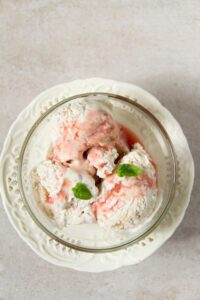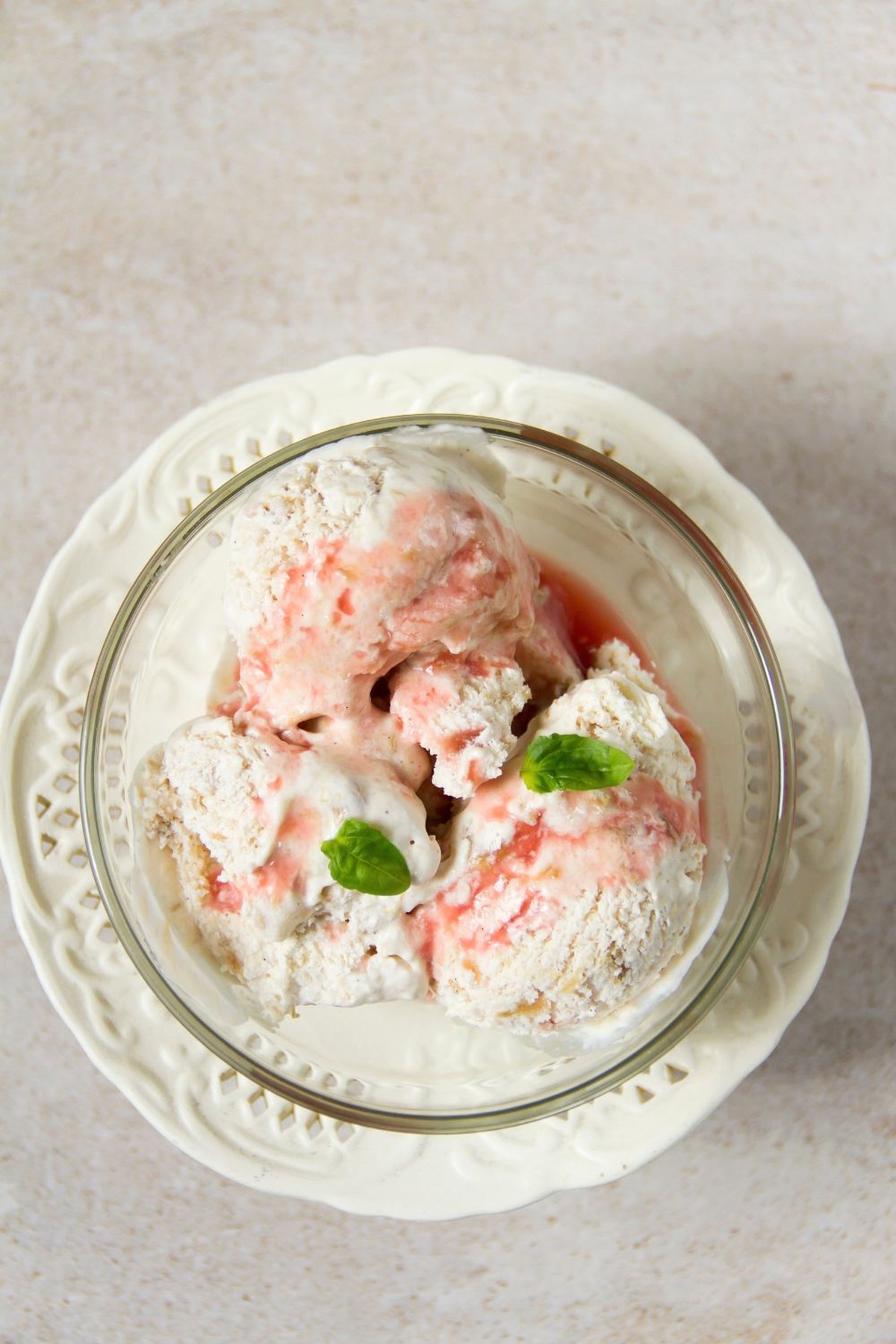Rhubarb Ice Cream Recipe That’s Sweet and Bright
Summer’s sweet adventures lead to unexpected delights with this creamy rhubarb ice cream that surprises every palate.
Tangy stalks blend into a silky dessert bursting with seasonal charm.
Vibrant pink hues peek through smooth, rich custard waiting to cool your senses.
Most people overlook rhubarb’s incredible potential beyond traditional pies and crumbles.
Our recipe transforms humble garden produce into an elegant frozen treat anyone can master.
Each spoonful promises a delicate balance between tartness and creamy sweetness that whispers of sunny afternoons.
You won’t believe how simple ingredients can create such magic in your kitchen.
Grab a scoop and let pure culinary joy take over!
What Makes Nigella Rhubarb Ice Cream A Summer Hit
Nigella Rhubarb Ice Cream Ingredients You’ll Need
Fresh Produce:Main Dairy Ingredients:Flavor Enhancers:Easy Steps To Make Nigella Rhubarb Ice Cream
Step 1: Prepare Rhubarb Chunks
Thoroughly rinse fresh rhubarb stalks under cool running water. Using a sharp knife, slice the rhubarb into small, uniform pieces approximately 1/2 inch long. Discard any tough or discolored sections.
Step 2: Create Rhubarb Compote
Place rhubarb pieces into a large saucepan. Sprinkle sugar over the rhubarb and stir gently to coat. Cover the pan and cook over medium-low heat, stirring occasionally. Simmer the mixture for 10-15 minutes until the rhubarb becomes soft and breaks down, creating a vibrant pink compote.
Step 3: Cool Rhubarb Mixture
Remove the pan from heat and let the rhubarb compote cool completely at room temperature. This cooling process helps intensify the flavors and prepares the mixture for blending.
Step 4: Blend Smooth Compote
Transfer the cooled rhubarb mixture to a blender. Pulse and blend until the compote becomes completely smooth and silky, with no visible chunks remaining.
Step 5: Incorporate Cream
Pour cold double cream into the blended rhubarb compote. Whisk thoroughly until the cream and rhubarb are fully integrated, creating a uniform pink mixture.
Step 6: Churn Ice Cream
Pour the rhubarb cream mixture into an ice cream maker. Churn according to the manufacturer’s instructions until the mixture thickens and develops a soft, creamy consistency.
Step 7: Freeze and Set
Transfer the churned ice cream into an airtight container. Smooth the top with a spatula and seal the container. Place in the freezer for at least 3 hours, or until the ice cream becomes firm and scoopable.
Helpful Tips For Nigella Rhubarb Ice Cream
Creative Ideas For Nigella Rhubarb Ice Cream
Tasty Pairings For Nigella Rhubarb Ice Cream
Store Nigella Rhubarb Ice Cream The Right Way
Nigella Rhubarb Ice Cream Question Guide
No, rhubarb leaves are toxic and should never be consumed. Only the stalks are edible and safe to use in cooking.
Yes, you can use the no-churn method by whipping the cream first and folding in the rhubarb compote, then freezing for several hours, stirring occasionally to break up ice crystals.
Rhubarb has a tart, tangy flavor similar to green apples, which is why it’s often paired with sugar to balance its natural sourness.
Print
Rhubarb Ice Cream Recipe
- Total Time: 3 hours 40 minutes
- Yield: 4 1x
Description
Homemade rhubarb ice cream offers a delightful twist on classic summer desserts, blending tart rhubarb with creamy sweetness. Cool, refreshing scoops invite cool exploration of seasonal flavors you’ll savor with each delectable bite.
Ingredients
Fruit and Base:
- 500 grams (17.6 ounces) rhubarb
Sweeteners:
- 250 grams (8.8 ounces) caster sugar
Dairy:
- 156 milliliters (5.3 fluid ounces) double cream
Instructions
- Thoroughly rinse fresh rhubarb stalks and slice into uniform small chunks to ensure even cooking.
- Place rhubarb and sugar in a spacious saucepan, covering the mixture and allowing it to gently simmer at low heat for 10-15 minutes until the rhubarb softens and breaks down completely.
- Remove the pan from heat and let the rhubarb compote cool to room temperature, preventing potential crystallization of sugar and maintaining smooth texture.
- Use a blender or immersion blender to puree the rhubarb mixture into a silky, uniform consistency with no visible chunks.
- Gradually fold cold double cream into the rhubarb puree, stirring methodically to create a harmonious, pale pink mixture.
- Transfer the liquid base into an ice cream maker and churn for 20-25 minutes, observing the gradual thickening and increasing volume of the mixture.
- Carefully decant the churned ice cream into a freezer-safe container with an airtight seal, smoothing the surface to prevent ice crystal formation.
- Freeze the ice cream for minimum 3-4 hours, or ideally overnight, to achieve optimal firmness and flavor development.
Notes
- Ensure rhubarb is chopped uniformly for consistent cooking and smooth texture.
- Adjust sugar levels based on rhubarb’s tartness, tasting the compote before adding cream.
- Chill all ingredients thoroughly to help the ice cream set faster and develop a creamier consistency.
- For a dairy-free version, substitute double cream with coconut cream or cashew cream for a rich, velvety alternative.
- Prep Time: 10 minutes
- Cook Time: 15 minutes
- Category: Desserts
- Method: Simmering
- Cuisine: American
Nutrition
- Serving Size: 4
- Calories: 259 kcal
- Sugar: 43 g
- Sodium: 2 mg
- Fat: 14 g
- Saturated Fat: 9 g
- Unsaturated Fat: 4 g
- Trans Fat: 0.5 g
- Carbohydrates: 36 g
- Fiber: 1 g
- Protein: 1 g
- Cholesterol: 50 mg






Michael Thompson
Founder & Recipe Developer
Expertise
Education
Cascade Culinary Institute – Bend, OR
ServSafe Food Handler Certification – Portland, OR
Focus: Certified in core food safety and hygiene principles for both home and professional kitchens, with emphasis on ingredient handling, kitchen cleanliness, and safe preparation methods.
Mike’s kitchen journey began with a single goal: to make everyday meals feel like something worth celebrating.
After earning his Certificate in Culinary Arts from Cascade Culinary Institute, he spent years working with local farmers and small kitchens across Oregon, learning the beauty of seasonal, small-batch cooking.
Mike’s approach is simple, cook with what’s fresh, keep it approachable, and always leave room for a little creativity. When he’s not testing yogurt marinades or designing single-serving meals, you’ll find him hiking trails or hunting down the best berries at local markets.